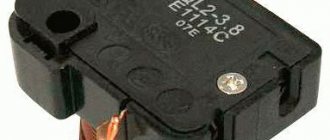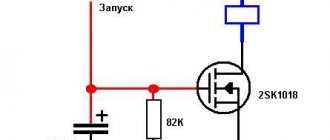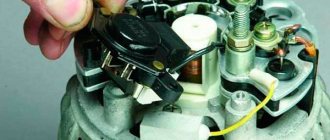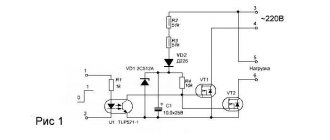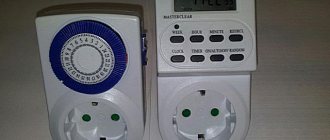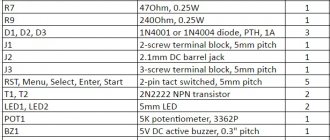Schemes of a 12V turn-on delay relay on a transistor + RC and ne555 for cars. TOP 5 popular transistors. 3 most frequently asked questions. Mini test. Let's look at 2 questions on the topic.
TEST:
Mini test for 4 questions.
We test ourselves for knowledge of the theory. What current will flow through the resistor if the voltage is 12V and the resistance is 200 Ohm?
A) 6A;
B)16mA;
B)0.06mA;
Please indicate the correct statement.
A) When connecting a positive potential to a p type junction and a negative potential to an n type junction, the current will be forward biased.
B) When connecting negative. potential to a p-type junction, and a negative one to an n-type junction, the current will be directly biased.
What is the difference between a field-effect transistor and a bipolar one?
A) Type of control of the output signal.
B) The number of pn transitions.
B) Internal structure.
A schematic representation of which is shown in the picture below.
A) Power source.
B) Capacitor. Answers on questions
Answer B). The current is calculated according to Ohm's law U=R*I. We substitute the variables and transform the equation 12V=200Ohm*I; I=12V/200 Ohm=0.06mA. Answer A). When + is connected to a p-type electrode, and – to an n-type electrode, a forward bias will occur, and current will flow in the circuit. If it’s the other way around, the current in the circuit will be minimal. All statements here are true! Answer B). This is a polarized capacitor
A turn-on delay relay is often called a timer or time relay in electrical and radio engineering literature.
An electronic delay relay is a device that functions as a time counter. After the specified interval has expired, the device turns on/off the devices it controls. Thanks to the ability to program the timer, the device has found wide application where cyclic switching of the operating modes of all devices connected to the relay is required.
The definition is generalized and is suitable for systems using integrated circuits (ICs) of the ne555 type. There are other ways to design timers without using an IC.
Using a capacitor paired with a resistor and transistor
Delay turning off and turning on the relay using a capacitor and 12V resistor
It is not necessary to resort to using integral timers like the NE555 if you only need a delay before start/stop. Using a capacitor paired with a resistor and transistor will solve the problem without complex ICs. Use the diagram below
This is a classic circuit using a capacitor, resistor, diode and bipolar transistor. The circuit uses an NPN type transistor. It works like this: after applying voltage to resistor N resistance, capacitor N capacitor begins to charge. When the bias voltage is reached, the diodes open, and then the control emitter pn junction of the transistor opens, which “opens” the transistor and the current begins to flow in the collector-emitter direction.
Our semiconductor operates in active mode. Until the current controlling the base leaves this mode, the gain will not take on a descending form. This continues until the current value completely crosses the cutoff threshold - the collector-emitter junction closes. When turned on, the opposite happens.
For assembly, it is recommended to use a KT827 transistor with an npn junction. The diode is suitable KD105B or similar in parameters. The capacitor and resistor are selected individually in each case, more on this below.
Easter basket bunnies
December 13, 2016 admin
Easter basket with bunnies. Patchwork Sewing Postila
Basket of rabbits for Easter. Pattern BLOG HOUSEWIFE
DIY Easter basket with bunnies. Master class with step-by-step photos / Masterclasses Blogs
Easter with animals.
Easter Basket With Eggs And A Bunny On A Green Meadow With Flowers Stock Photo, Picture And Royalty Free Image.
Easter. Easter basket. Master Class. razpetelka.ru
Life is full of red and black crosses. — Easter basket with bunnies. Patchwork
Easter Rabbits with a basket of eggs - Photo, image, buy posters, order posters, paintings on canvas. — Russia — Posterok.com
We sew Easter baskets - sewing
Easter bunnies. Discussion on LiveInternet - Russian Online Diary Service
Basket HARE COUNTRY EASTER Orange Gifts
Easter. Easter basket. Master Class. razpetelka.ru
Baskets, boxes “Bunnies and Bunnies”. Discussion on LiveInternet - Russian Online Diary Service
Sunny bunnies Happy Easter
Stickers Easter basket 48292 production and printing to order in Minsk
Basket with bunnies / DIY / basket with flowers with your own hands / Pinme.ru / Pinme
Easter wallpaper. Discussion on LiveInternet - Russian Online Diary Service
Easter ideas and inspiration. Continuation.
rabbit basket with bow. square
Easter. Hares with a basket of eggs — Stock photo Natalia Preobrazhenskaya (natalinka) (#2023425) Stockfresh
Leave a comment
How to calculate delays on rc circuits for 12V relays
The RC circuit is based on several phenomena and properties of a capacitor: to accumulate opposite charges on its plates, without passing current through itself, and instantly release the charge back into the circuit. Due to the fact that the two plates of the capacitor are insulated with a dielectric, “stirring” occurs in the external circuit during discharge or charging.
Another useful property of a capacitor is that as it charges, the voltage equals the voltage of the charge source, after which the current in the circuit stops flowing because potentials are equalized. The duration of charging the condenser depends on its capacity and the resistance of the source.
But what does instantaneous discharge of a capacitor give us if a delay is required? Nothing. Therefore, a passive semiconductor - a resistor - comes to the rescue.
The only function of a resistor is to limit the current by dissipating the excess as heat. By adjusting the current, you can set the charging or discharging time of the capacitor. The greater the current resistance and capacitance of the capacitor, the longer it will take to discharge and charge.
All this suggests an obvious conclusion - a capacitor paired with a resistor will serve well as a timer.
How to calculate and make a delay for turning on a 12V relay for 3 seconds
As we found out, the delay time directly depends on the capacitance and resistance. This formula is useful for the calculation:
T=RC,
where T is time in seconds, R is the resistance, in our case a resistor, and C is the capacitance of the capacitor in farads.
IMPORTANT! Capacitance is calculated in farads. Typical Conders have capacitance in microfarads or even pico and nanofarads, so all calculations are converted to SI (International System of Units). 1 microfarad is 10-6 (power) and equals 0.000001 farad!
There is no point in installing a large capacitor. The 1 farad capacitance is so huge that it cannot be grasped with one hand. Therefore, we use a capacitor of 50 uF or more and select a resistor.
Now we use the formula above and substitute the parameters of the elements in place of the variables:
3с=R*0.00005;
Let's transform the equation:
R=3c/0.00005=60,000Ohm
This is how we found the required resistor so that the 50 µF condenser would be charged within approximately 3 seconds. Its resistance is 60,000 Ohm => 60 kOhm. Do not forget that the conductor also has its own resistance, but it makes no sense to take it into account in our calculations, because Latencies will increase by milliseconds or less.
Scope of application of time relay
Man has always sought to make his life easier by introducing various devices into everyday life. With the advent of electric motor-based equipment, the question arose about equipping it with a timer that would control this equipment automatically.
Turn it on for a specified time - and you can go do other things. The unit will switch itself off after the set period. For such automation, a relay with an auto-timer function was required.
A classic example of the device in question is in a relay in an old Soviet-style washing machine. On its body there was a handle with several divisions. I set the desired mode, and the drum spins for 5–10 minutes until the clock inside reaches zero.
The electromagnetic time relay is small in size, consumes little electricity, has no breakable moving parts and is durable
Today, time relays are installed in various equipment:
- microwaves, ovens and other household appliances;
- exhaust fans;
- automatic watering systems;
- automatic lighting control.
In most cases, the device is made on the basis of a microcontroller, which simultaneously controls all other operating modes of automated equipment. It's cheaper for the manufacturer. There is no need to spend money on several separate devices responsible for one thing.
Based on the type of element at the output, time relays are classified into three types:
- relay - the load is connected via a “dry contact”;
- triac;
- thyristor.
The first option is the most reliable and resistant to network surges. A device with a switching thyristor at the output should be used only if the connected load is insensitive to the shape of the supply voltage.
To make your own time relay, you can also use a microcontroller. However, homemade products are mainly made for simple things and work conditions. An expensive programmable controller in such a situation is a waste of money.
There are much simpler and cheaper circuits based on transistors and capacitors. Moreover, there are several options; there is plenty to choose from for your specific needs.
Turning on a 12V relay with a delay on a capacitor and resistor without a diode
In the circuit discussed earlier, there were two diodes. They were used to quickly discharge the capacitor when changing polarity. The effect of instant attenuation of the system occurred, without delays. Now we are presented with a circuit with a delay for turning off and turning on without diodes. It uses an N-channel field-effect transistor - a power mosfet. The field switch is controlled by voltage, not current, so this approach is less current-hungry - this is a very big plus.
An N-channel mosfet opens when a positive potential is applied to the gate relative to the source. An 82kOhm resistor is pulled to ground to close the transistor when the power is cut off, because The mosfet will not turn off on its own. Another function of the resistor when connected in parallel with the conductor is to limit the current supplied to the gate. To adjust the delay time, it is necessary to experimentally select the capacitance of the condenser and the resistance of the circuit. According to experiments, an 82 kOhm resistor paired with a 470 uF capacitor shows a delay time of 55 seconds.
Diagram of a 12 volt time relay (RT) with a shutdown delay for a car
Scheme of a time relay (RT) 12 volts with a shutdown delay for a car
GOST R 50571.3-94 clause 412.1 requires that all current-carrying conductors be covered with insulation. Clause 411.1.3.1 reminds you that all electrical lines of devices in the circuit must be separated from each other.
Let's take a closer look at the 12 volt connection diagram with a turn-on delay for a car. +12 we take from the cigarette lighter, out +12 is a mounted device, which is controlled using a relay, GND – ground, IN – control, connects to something that will switch our relay. C1 and R1 are responsible for the shutdown delay time. In order for field switch V1 to close, there must be no voltage at the gate. R1 pulled to the ground will take care of this. R1 also acts as a voltage regulator at the gate of V1.
The formula T=RC will calculate the required ratings R1 and C1. For a more accurate calculation, it is also necessary to take into account the gate-source resistance and the relay release current. Therefore, it is easier to find the values of elements using the selection method rather than calculations using formulas. According to experiments, a 5 μF capacitor and a 1 MΩ resistor are enough for 10 seconds of delay
Device
Our recommendations:
If you are looking for a good online electrical store, we recommend visiting the 220 VOLTS store. If you don’t want to bother with electrical work yourself, we recommend looking for a professional technician on the website Remontnik.ru
In order to understand how an electronic relay works, it is useful to remember the old mechanical time regulators. For example, in previous washing machines, turning the handle on the body activated the actuator. At the same time, the shutter speed was started. After a specified time, the actuator was turned off. Any time switches or timers work according to this algorithm, even those located in a microcontroller (MK).
Although today, in the age of electronics, there are a lot of electronic clock mechanisms and relays, the question arises about the need to make a mechanism that regulates time with your own hands. The answer is very simple. Often you have to do something at home that requires measured time limits. Therefore, it is possible to assemble simple time regulation mechanisms yourself, with your own hands.
You can also assemble multifunctional relay devices with your own hands, which can be used in the household. They can be used to control heating, ventilation and lighting on and off. Multifunctional devices can operate at any specified time intervals. The delay can be adjusted in the range from 0.1 sec to 24 days, while the supply voltage can be from 12 to 220 V AC or DC.
The main functions of the relay in such cases are considered:
- Switch-off delay due to switching contacts
- Device response delay.
Do-it-yourself 12V turn-on delay relay (RD) on the ne555 and k561ie10 microcircuit
Ne555 - IC, a device for generating pulses at certain intervals, in simple terms - a timer, in technical terms. In the literature, the monovibrator k561ie10 is an analogue of the ne555, but only a dual multivibrator in one housing.
12V turn-on delay relay (RD) on ne555 and k561ie10 microcircuit
Above is a delay circuit for turning on a 12V relay without transistors using the ne555 universal timer. Capacitor C1 and resistor R1 are responsible for the delay time. Use the formula shown in the picture above to calculate the delay time. Note that the constant variable 1.1 is used here and its use is mandatory.
The device works approximately like this: after power is applied, the timer starts, then after the time has elapsed, pin 3 of the OUT chip generates a pulse that closes the relay. Diode VD2 is installed to ensure reliable operation of the relay. VD1 protects the timer from random pulses from the power supply side of the IC.
Automotive timing relay 12 volts with DRL activation delay on 555 timer
We have already considered an example with a turn-off delay using a time-setting RC circuit and a transistor. Now let's do the same thing only using the ne555 timer for DRLs. We will need a ne555 monoborator, 3 25V conductors for 10.22.0.1 µF, one diode of any kind. The pictures below show the upgrade of relay 23.3787. We do everything by analogy. C1 and R1 set the delay. A capacitance of 10 μF and 1.3 MΩ is enough for about 10-13 seconds, so if this is not enough or a lot, we use the formula T = 1.1 * RC for calculation.
Automotive timing relay 12 volts with DRL activation delay on 555 timer
Delay relay circuit on ne555 turn off 24V with your own hands without a transformer
Do not forget that the current PUE regulates the grounding requirements for all devices operating from a 380V network. And devices operating from 42-380V AC must be grounded in places and rooms with increased fire hazard. IEC 364-4-41 requires the grounding of all devices operating at a voltage of 50V and above, and the grounding of devices from 25V in particularly hazardous areas.
Delay relay circuit on ne555 switch off 24V without transformer
According to the principle of operation, the previous circuit differs only in the addition of a voltage multiplier assembled on diodes VD1, VD2 and capacitors C3, C4. The multiplier can only operate in an AC circuit due to the fact that in the first half-cycle, one section of the diode + conductor is charged, and in the second half-cycle, the second assembly is charged. Periodic changes in the direction and magnitude of the current are not typical for constant voltage. Our connectors are connected in series, so the sum of their voltages doubles, and the output becomes 24V.
Scheme for 220 Volts
Timers on transistors and microcircuits operate from 5–14 V (standard from 12 V). 220 Volt time relays are diode assemblies with magnetic starters. If the equipment being serviced is low-power (for example, lighting, lamps, soldering irons, boilers, small motors, etc.), then the latter need not be installed - the diode bridge and thyristor transform the voltage themselves.
Let's look at the light bulb timer, the main parts: diode bridge, thyristor. It is not recommended to connect any other load: the thyristor will only pass a positive sinusoid of 220 Volt variables. This is enough for the listed consumers, but other electrical appliances may not be able to withstand it.
What you will need:
- resistors: 4.3 mOhm (R1), 200 Ohm (R2) and adjustable 1.5 kOhm (R3);
- 4 diodes with max. current from 1 A, reverse voltage from 400 V;
- capacitor 0.47 µF;
- thyristor (analogs are possible) BT151;
- regular microswitch.
The principle is standard for such assemblies: gradual charging of the AC. C1 (starts after activation of S1). Thyristor VS1 is open, and load L1 receives 220V from the network. After charging, it closes, cutting off the current - the lamp turns off. The pause is regulated by setting the value to R3 and selecting capacitance C1.
The assembly has a disadvantage: touching any exposed wiring or leg can result in a strong electric shock, since the elements receive a strong current.
Delay for turning on the 5V relay after powering up the Arduino
To make a time relay on Arduino we will need:
- Arduino uno module – 1000-1200 rubles;
- 1 button – 5 rubles;
- Relay 5V Arduino PIC ARM – in China costs 100-200 rubles;
- 5V power supply - they cost pennies, even a computer ATX power supply unit or a mobile phone charger power supply unit will be useful if powered correctly;
- Trimmer resistor;
Video. How to make a 5V time relay on Arduino
Watch the video attached above, where the author explains in detail how to connect and program an Arduino for a time relay. Let's add that the delay time is controlled by a trimming resistor.
Using and connecting a time relay
What else is important to know? 2 interesting facts
3T=RC
The considered formula T=RC has a certain peculiarity. Time T is only 63% of the maximum charge, 95% is 3T.
Voltage versus time
During discharge, an inversely proportional relationship occurs. During time T, the capacitor will discharge to 37%, after 3T to 5% of the maximum. This happens because with an increase or decrease in the internal charge, the potentials gradually equalize.
That is, let’s assume that in 10 seconds the condenser is charged to 95%. Charging voltage 10V, circuit resistance 10Ohm, current 1A. At the seventh second, the voltage in the circuit will drop by 30% and become 7V. This happens because the potential begins to equalize as the capacitor charges. Consequently, the current in the circuit will also drop by 30% - to 0.7A. And this will happen until equilibrium is established in the chain.
AC voltage
Sinusoidal voltage has several phases. At the peak of the ascent, when the half-cycle ends, the current reaches its maximum value. This peak shows the peak current, the maximum instantaneous value of the alternating current, which is 1.4 times higher than the rms value. That is, the 220V alternating current we are considering at some point in time reaches a peak of 308V.
IMPORTANT! Therefore, in any alternating current circuit, a capacitor is selected based on the amplitude value, and not the effective value, which is 1.4 times higher! If the input current is 12V, then the condenser must be set to at least 20V!
TOP 5 transistors for circuits with a delay on/off of a 12V relay
| Name | Class | Frame | Price |
| 2SK1018 | Mosfet N-channel | TO-3P | 400 rubles |
| 2N2222 | Bipolar NPN | TO-92 | 10-15 rubles |
| KT973A | Bipolar PNP | TO-126 | 25-30 rubles |
| KT816B | Bipolar PNP | KT-27 | 15 rubles |
| IRF620 | Mosfet N-channel | TO-220 | 30-40 rubles |
How to avoid 3 mistakes when selecting and installing a transistor
When selecting a bipolar transistor, you should pay attention to parameter h21. H21 is the gain of the collector current relative to the base current. If the value of this parameter for the transistor is 30, then the analogue should be selected such that the value of h21 is no less than 30.
To determine which npn or pnp transistor structure to use in the circuit, use this simple rule: if the control signal arriving at the base is negative. then type pnp is put, if positive - npn. Please note that the base signal must be of the same polarity as the supply voltage!
The relay has a high self-inductive emf value of several tens of volts when the circuit breaks. Therefore, the collector junction should be protected with a parallel diode. The diode is placed opposite the polarity of the power source: cathode to positive, anode to negative.
DANGEROUS! If this is neglected, the transistor will fail at the first switching.
Video of 12V time delay relay
Answers to the 2 most asked questions
- Question.
Are there any analogues for ne555?
Answer:
Yes very many. All are similar to each other, like two peas in a pod in terms of internal architecture. KR1006VI1 - the closest domestic analogue of ne555
- Question.
How does a relay work?
Answer:
the relay consists of an armature, electromagnets and switching elements. When a current of the required magnitude is supplied to close the contacts, the armature closes - the relay begins to pass current. When the control current decreases to the cut-off value, the armature opens to its original position due to the constant mechanical spring pressing on it - the current stops flowing.
Compressor malfunction: symptoms
Quite often, refrigeration equipment breakdowns occur due to a compressor malfunction. Most often, this problem can be recognized by the following signs:
- noticeable blocks of ice freeze on the walls of the refrigerator (this often happens in the absence of a No Frost system);
- When the compressor is running, a loud sound is heard, but the refrigerator does not freeze;
- When the refrigerator is turned on, there is strong vibration;
- the compressor does not turn off;
- The refrigerator freezes food.
In order to deal with the problem, it is necessary to consider the signs of breakdown in more detail.
Table 2. Signs of compressor failure
| Breaking | Causes |
| The compressor works, but does not freeze | The cause of the problem is often a refrigerant leak due to improper transportation of the unit. In addition, this occurs in the event of a malfunction of the heating element. |
| The compressor does not stop working | This problem occurs for the following reasons:
If the refrigerator has an inverter-type compressor, then after reaching the desired temperature, it still functions, but only at minimum speed. |
| The compressor hums but does not function | Extraneous noise during compressor operation often occurs when there are bolts that must be removed after transportation. However, this only applies to new devices. There are other reasons for the malfunction:
|
| Refrigerator compressor turns on and then immediately stops | The following causes of malfunctions are identified:
|



